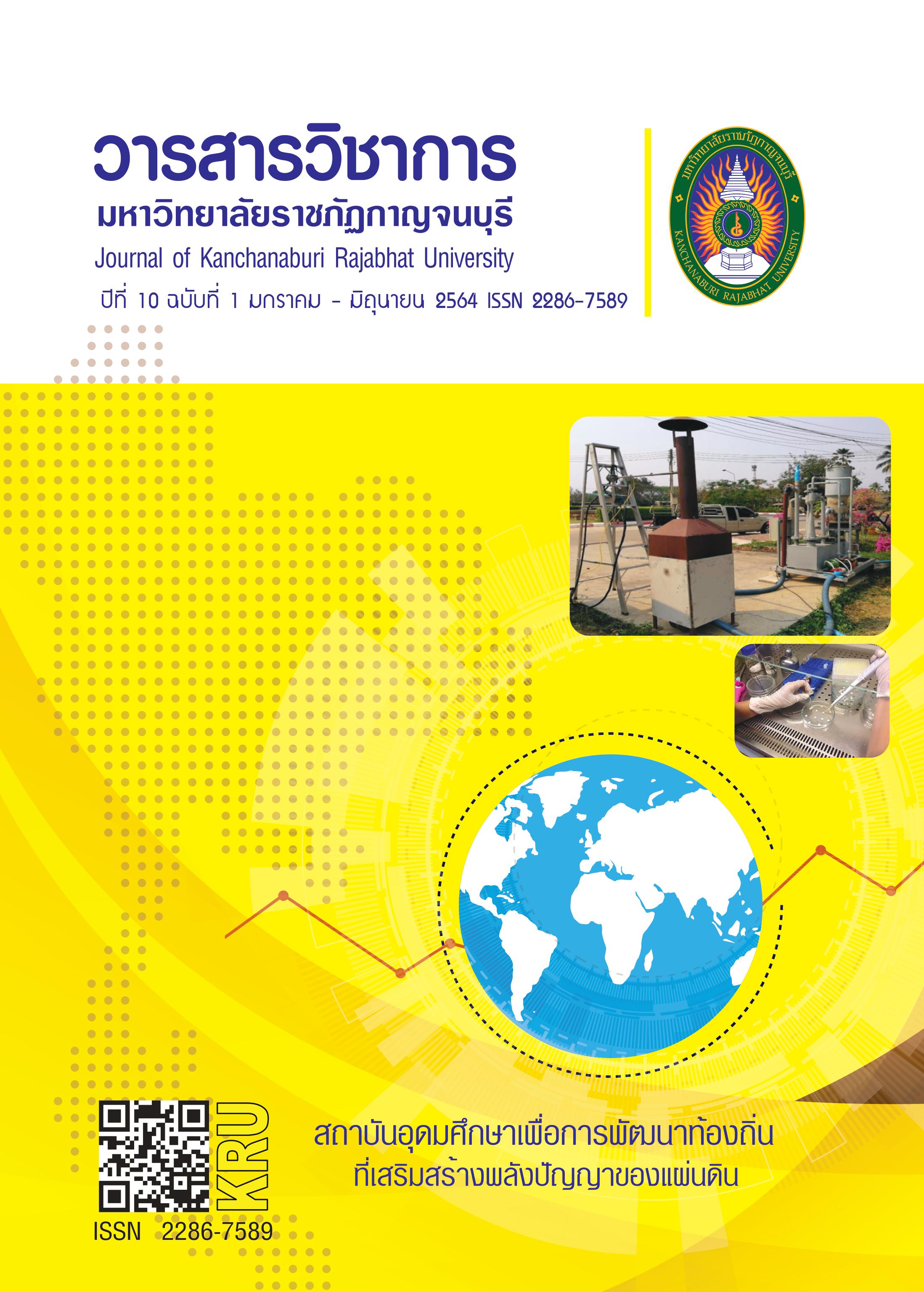INTERNET USAGE BEHAVIOR OF STUDENTS IN THE FACULTY OF EDUCATION, KANCHANABURI RAJABHAT UNIVERSITY
Main Article Content
Abstract
The purposes of this research were to study the internet usage behavior of students in Faculty of Education, Kanchanaburi Rajabhat University and to compare the internet usage behavior of the students according to the gender variables and subject areas of the sample group derived from stratified sampling and comprising 450 students in Faculty of Education in the following programs: Physical Education, Thai Language, Social Studies, Mathematics, Science, English, Early Childhood Education, Sports Science, and Educational Technology and Computer Studies in the academic year 2020. The instrument used for data collection was a questionnaire created by the researcher. The reliability was 0.95. The data were analyzed by means of standard deviation, t-test independent and One-Way Analysis of Variance and Scheffe’s Method test.
The result of the research showed that most of the students used the Internet more than 7 times. The average internet usage was 4 hours each time. The period in which the students used the Internet regularly was during 20.00-23.00 pm. The average internet usage fee was 200-400 baht per month. In terms of the Internet usage behavior for education purposes, most students used the Internet to search for knowledge on various websites. In terms of the Internet usage behavior for entertainment purposes, most students used online social media, Facebook, Instagram, LINE and Twitter. In terms of the Internet usage behavior for business purposes, most students used the Internet to purchase products or services. Most students used the Internet every day for emotional purposes. In overall, most students would choose to use the Internet in their free time to watch movies and listen to music rather than read books, watch TV, exercise or walk around the mall. The hypothesis testing found that personal factors such as gender affected the Internet usage behavior, and that students studying in different subject areas had different Internet usage behaviors at the statistically significant level of .05.
Article Details
References
กิตติพศ ทูปิยะ. (2560). พฤติกรรมการใช้อินเทอร์เน็ตและสารสนเทศของนิสิตมหาวิทยาลัยบูรพา. กลุ่มวิชาการ
จัดการภาครัฐและภาคเอกชนวิทยาลัยการบริหารรัฐกิจ มหาวิทยาลัยบูรพา.
เกียรติสุดา ศรีสุข. (2552). ระเบียบวิธีวิจัย. เชียงใหม่ : ครองช่าง.
จินตนา ธนวิบูลย์ชัย. (2545). การพัฒนาเครื่องมือสำหรับการประเมินการศึกษา. หน่วยที่ 8-15 นนทบุรี :
มหาวิทยาลัยสุโขทัยธรรมาธิราช.
จีรวรรณ ศรีวงษ. (2554). พฤติกรรมสารสนเทศของนักศึกษาระดับปริญญาตรีมหาวิทยาลัยธรรมศาสตร์.
กรุงเทพฯ : ภาควิชาบรรณารักษศาสตร์ คณะศิลปศาสตร์ มหาวิทยาลัยธรรมศาสตร์.
ชัชพงศ์ ตั้งมณี. (2545). พฤติกรรมการเสพติดอินเตอร์เน็ตของนิสิตจุฬาลงกรณ์มหาวิทยาลัยกรุงเทพฯ.
ภาควิชาสถิติจุฬาลงกรณ์มหาวิทยาลัย.
ชเนตตี สยนานนท์. (2555). พฤติกรรมและปัญหาการใช้อินเทอร์เน็ตของนักศึกษาระดับปริญญาตรี. มหาวิทยาลัย
ราชภัฎบ้านสมเด็จเจ้าพระยา. ปริญญานิพนธ์การศึกษามหาบัณฑิต สาขาวิชาการอุดมศึกษา
บัณฑิตวิทยาลัย มหาวิทยาลัยศรีนครินทรวิโรฒ.
ทวีลาภ ตั๊นสวัสดิ์. (2553). พฤติกรรมการใช้อินเทอร์เน็ตและผลกระทบต่อสุขภาพ. ของนิสิตมหาวิทยาลัยบูรพา.
วารสารโรงพยาบาลชลบุรี, 41(1), 39-46.
ทิพวรรณ จําปาเงิน. (2555). พฤติกรรมสารสนเทศของนักศึกษา. มหาวิทยาลัยเทคโนโลยีราชมงคลกรุงเทพ.
วารสารมหาวิทยาลัยเทคโนโลยีราชมงคล, 8(1), 37-48.
พิชิต ฤทธิ์จรูญ. (2544). ระเบียบวิธีการวิจัยทางสังคมศาสตร์. กรุงเทพมหานคร : ศูนย์หนังสือราชภัฏพระนคร.
พัชรี ถุงแก้ว. (2558). พฤติกรรมการบริโภคสื่ออินเทอร์เน็ตของนักศึกษาคณะครุศาสตร์ มหาวิทยาลัยราชภัฏ
บุรีรัมย์ นเรศวรวิจัย ครั้งที่ 13 : วิจัยและนวัตกรรม ขับเคลื่อนเศรษฐกิจและสังคม.
เพ็ญแข แสงแก้ว. (2541). การวิจัยทางสังคมศาสตร์ (พิมพ์ครั้งที่ 3). กรุงเทพมหานคร : มหาวิทยาลัยธรรมศาสตร์.
ศรีศักดิ์ จามรมาน และกนกวรรณ ว่องวัฒนาสิน. (2542). Y2K คอมพิวเตอร์ปี 2000 : ปัญหาที่แท้และทางแก้ไข
ที่ถูก. กรุงเทพฯ : มหาวิทยาลัยอัสสัมชัญ.
อริศรา คงสนิท. (2556). เทคโนโลยีอินเทอร์เน็ต. ค้นเมื่อ กรกฎาคม 1, 2560, จาก http://arissaramay.
blogspot.com/
อุทุมพร จามรมาน. (2544). แบบสอบถาม : การสร้างและการใช้ (พิมพ์ครั้งที่ 6). กรุงเทพฯ : ฟันนี่พลับบิชชิ่งจำกัด.
Krejcie, Robert V.; & Morgan, Daryle W. (1970). Determining Sample Size for Research Activities.
Educational and Psychological Measurement, 30, 607-610.
Neil J.Salkind (2006). Exploring Research . 6th New jersey ; Pearson Prentice Hall.


